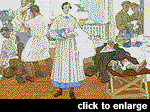
|
 |
During the third year of the First World War, 1914-1918, Max Aitken, a young Canadian from Newcastle, New Brunswick, was in charge of the Canadian War Records Office in London. Due to the shortage of photographs recording Canadian contributions to the war, Aitken proposed that artists record the outstanding work of the Canadian overseas forces. Aitken's proposal resulted in the creation of the Canadian War Memorials Fund which "offered artists a full-time opportunity to paint, officer's rank and pay, current acclaim by the art critics and public institutions, and the chance for recognition by posterity"(Tippett, p. 13). By the summer of 1917 Lord Beaverbrook--Aitken had been elevated to the peerage in January--was commissioning paintings, sculptures, and prints. Some 850 works, known as the Canadian War Memorials Collection, was the end product of this ambitious endeavour.
During the third year of the Second World War, 1939-1945, the Canadian War Artists' Committee was established. Shortly thereafter a war art program was launched through the efforts of Vincent Massey and the director of the National Gallery of Canada, H.O. McCurry. Under the jurisdiction of the Department of National Defence the end product of this artistic labour became known as the War Records Collection. The majority of these 1000 creations, along with the greater part of the Canadian War Memorials Collection, were transferred to the Canadian War Museum in 1971. The art works selected for this site were obtained from the Canadian War Museum's collection. We thank Laura Brandon, Chief Curator at the Canadian War Museum, for her assistance.
|















